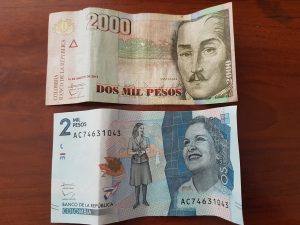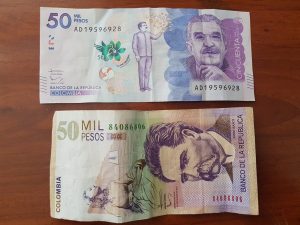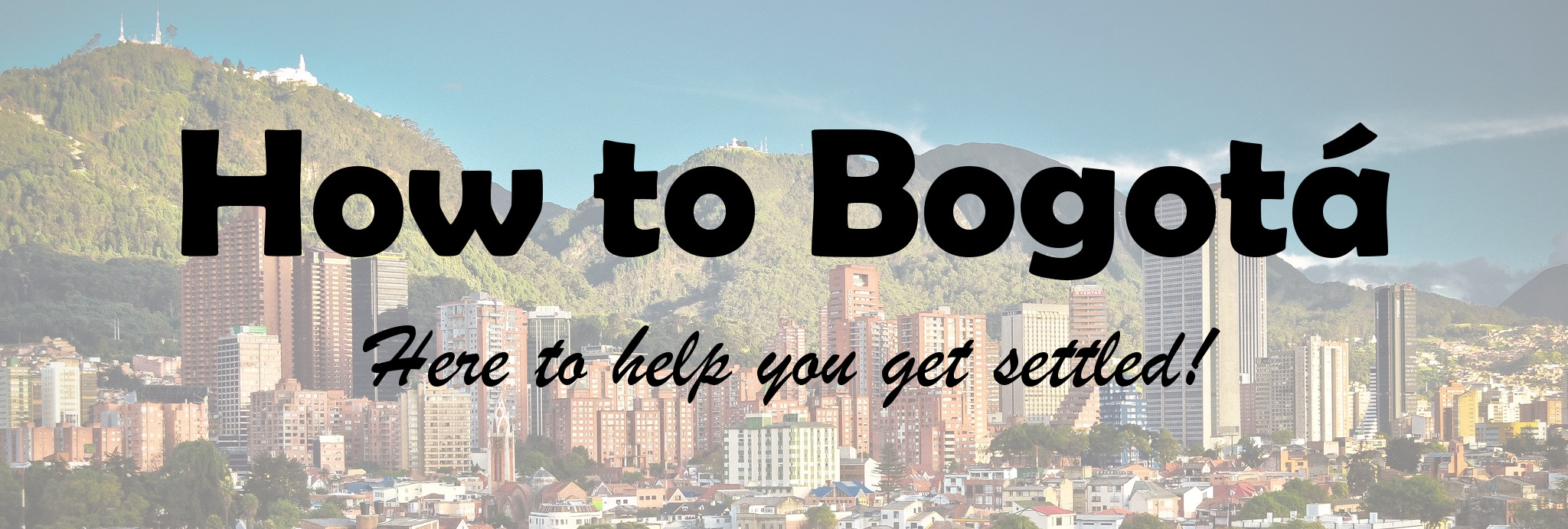Colombia currency: the Colombian peso
I had a request recently from someone who wanted me to write a blog post about Colombia’s currency. They had recently arrived in Bogota and had exchanged some dollars for Colombian pesos. At the time of writing, there were about 3,000 pesos to the dollar. This means that if you wanted to change $1,000 US dollars, you’d receive about $3 million pesos. All those zeros (and a number of other issues) can make things pretty confusing! Here are a few things to keep in mind regarding Colombia currency:
You can’t buy it abroad
Or at least it won’t be easy to find. Most exchange bureaus won’t stock Colombian pesos (except, perhaps, in neighbouring countries like Venezuela and Ecuador) as it’s considered a volatile currency, with the exchange rate fluctuating on a daily basis. To give you an example, when I moved to Colombia in 2013, there were $2,800 pesos to £1.00. At the time of writing, £1 will buy you nearly $4,000 pesos, and at one point at the end of 2015, it went up to $5,000 pesos. The best thing to do is bring dollars or euros to exchange in Colombia (these are the currencies that will allow you to get the best exchange rates), or withdraw money from banks using your card. And needless to say, make sure you exchange all of your leftover Colombian pesos before leaving the country!
There are now two versions of Colombian pesos
Just to make things easier for tourists(!), the Colombian government changed the design of the notes in 2017 without taking the old notes out of circulation. So there are now two sets of notes circulating, both valid and accepted everywhere. You are therefore likely to receive a combination of the two whenever you’re exchanging money or given change in shops and restaurants. Here are two examples below of the 2,000 pesos notes and the 50,000 pesos notes:


There are also two versions of all of the coins (except the 1,000 pesos coin). Generally, the older version is a bit larger, and the newer versions are smaller and shinier. Both old and new are still accepted everywhere.
Sometimes they miss out a few zeros…
Notice that on the notes above, they don’t always include all the zeros. For example, the new 2,000 pesos note just says “2 MIL PESOS” using the Spanish word for thousand. Both 50,000 pesos notes say “50 MIL PESOS”. This could be confusing, especially if you’re wary of being conned or short-changed.
Coins and notes
The following coins exist in Colombian currency: 50 pesos, 100 pesos, 200 pesos, 500 pesos, 1,000 pesos.
The following notes exist: 1,000, 2,000, 5,000, 10,000, 20,000, 50,000, and the newly released 100,000. I recommend trying to break a 50,000 note whenever you can (restaurants, supermarkets) as many shops will ask you for something smaller if you’re buying something cheap, and taxi drivers HATE being paid with 50,000! The 100,000 note is new and there may be establishments that don’t accept them, so again, I’d say break them whenever you get a chance (and always check your change!).
Have I forgotten anything? Let me know in the comments section below!

There are also two types of 200 and 100 peso coins! Sometimes vending machines only take the old or the new ones. Not something to worry about on a daily basis though 🙂
Oh yes, you’re right! And there are two types of 50 pesos coins! At least we don’t have to worry so much about being given fake coins in our change though 🙂
Thank you for all those info. Very useful. I always want to have some change before leaving Europe just in case and it is not always possible unfortunately!
There is clearly fees with ATM and the offices at the airport always apply unfavourable rate.
Just discovered a new mobile app for my next trip Fairswap. It allows to exchange cash currency in real-time by meeting with each other at a pre-agreed location.
Widely, you can post your need in foreign currency and if there is someone nearby facing the reverse need, then he can contact you and you will meet him and make the swap.
Wow that’s excellent! We need to spread the news about this app, it’ll be useful for so many people! Thanks for sharing!
You say “There are also two versions of all of the coins (except the 1,000 pesos coin). Generally, the older version is a bit larger, and the newer versions are smaller and shinier.”
I didn’t realise that there are two type os 500 pesos coins, thought there was only one. Please correct me if I’m wrong, or the article if I’m right?
I believe there are different designs on the 500 pesos coins depending on how old they are, but I think the size is always the same. The difference between the 50, 100 and 200 coins is greater because the new coins are smaller.
Thank you for this resource. I just got home after my first-ever trip to Bogota. I was just visiting for a few days-not moving there-so I know I’m not your target audience but your blog was incredibly helpful to me in planning my trip.
I do have one suggestion on the currency topic: counterfeit currency. Maybe you cover it already elsewhere else, but it would be a useful addition to this article about currency. I was only there for five days and I unknowingly received two fake 20,000 peso notes. It wasn’t until I tried to use the notes that the person I was trying to pay showed me that it wasn’t real. After they pointed out the differences between a real note and the fake one, I saw the differences. But when I was receiving the false notes I was too ignorant to look for, much less detect, their falsity. Perhaps your audience would benefit from a heads-up in this column about currency. Or at least a link to wherever else you cover that topic? Thanks again for your wonderful work!
Hi Elizabeth, I’m glad you found the blog helpful in planning your trip and am very sorry to hear you were tricked with false currency! This hasn’t happened to me before but I know it can happen and that they target unsuspecting foreigners! I will update this post as you suggest 🙂 I hope you enjoyed your time here otherwise!
Where can we cash in lots of coins?
You should be able to do it at a bank – try asking at a few different banks if necessary.
I recently came across some food products and its prices were written as $3.000, $4.000, $6.000. My question is, are these decimals indicates ‘Mil’ or just 3,4,6 pesos. Those were dessert and sweet products. Waiting for reply…
Hi, is colombia still accepting the older pre 2017 bills in 2023? I still have some leftover from my previous travels.